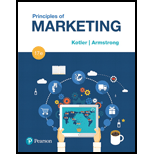
Case summary:
N Company a video streaming service is expanding all over the globe. By the end of 2016, N Company currently has services in 50 countries and wants to expand its service to 200 countries. N company is tending to face many challenges like inadequate household income and lesser percentage of households with high speed internet connections.
It also faces language challenges in F Country as there is a cultural restriction for some English content programs. The next countries to have N Company are Country I, Country S, and Country P. The offerings of N services will be at a price of €7.99 per month coverts to $8.97 during the period of expansion.
To determine: The annual market sales potential for Country S in euros and dollars.
Market demand refers to the total volume a group of consumers buy in a defined time. Defined geographical area, defines
Want to see the full answer?
Check out a sample textbook solution
Chapter 19 Solutions
Principles of Marketing, Student Value Edition Plus MyLab Marketing with Pearson eText -- Access Card Package (17th Edition)
- In your expert opinion, what do you think is the most effective and efficient way for small business owners to promote and market their products/services? Why? How have you seen the use of referrals and word of mouth advertising work to the benefit of a small business owner? Please would you kindly provide some examples. How have these methods worked in reverse (to the disadvantage of the owner but possibly benefit the competition)?arrow_forwardIn your Expert Opinion, How do the risks differ when you start your business using a purely product development process versus a purely customer development process approach? What are the elements that go into a customer profile and why is each one useful? What are some of the ways that you could use secondary research to better understand the various segments of your market and to develop promotional materials?arrow_forwardWhat marketing challenges might arise should a major health care provider stop offering a product or service that is socially popular but economically unprofitable? What marketing elements should be considered before a health care provider eliminates such a product or service?arrow_forward
- Choose a company, conduct an in-depth analysis of the identification of variables that are the target of the company's market segmentation, and provide examples of what the company has done to meet its targetsarrow_forwardTravel agencies lose business because passengers book their flights directly on airline websites. give me suggestion on the possible new business line options for passengers who wish to travel, so that the company can replace the loss of airline ticket sales at the agency.arrow_forwardOne of our favourite products is a mobile phone. One popular brand is the Clear Voice GA8. Theproduct is a midrange mobile handset with amazing features and benefits. Some of the phone’s iconicfeatures include a large 4 GB RAM, 166g weight, a durable Corning Gorilla Glass 3, 25MP cameras, anenhanced octa-core processor, 64GB of internal memory, fast battery charging, and fingerprint sensor.These features make the product an outstanding offering in the midrange phones market. Before itsrelease in 2019, purchasing a handset with similar features was a luxurious venture only left to theelite and wealthy persons in society.The product has a lot of benefits depending on the user. Users enjoy multiple benefits from the ClearVoice GA8. It does not lag due to the inclusion of Mali G72 MP3 in its processor (“A 8,” n.d.). As such,the product allows for the performance of multiple actions simultaneously. The gadget has anexpandable memory of up to 128GB. It, therefore, allows the user to save as…arrow_forward
- MarketingMarketingISBN:9780357033791Author:Pride, William MPublisher:South Western Educational Publishing
 Foundations of Business (MindTap Course List)MarketingISBN:9781337386920Author:William M. Pride, Robert J. Hughes, Jack R. KapoorPublisher:Cengage Learning
Foundations of Business (MindTap Course List)MarketingISBN:9781337386920Author:William M. Pride, Robert J. Hughes, Jack R. KapoorPublisher:Cengage Learning Foundations of Business - Standalone book (MindTa...MarketingISBN:9781285193946Author:William M. Pride, Robert J. Hughes, Jack R. KapoorPublisher:Cengage Learning
Foundations of Business - Standalone book (MindTa...MarketingISBN:9781285193946Author:William M. Pride, Robert J. Hughes, Jack R. KapoorPublisher:Cengage Learning




